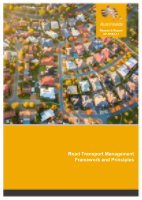Network

- Publication no: AP-R552-17
- ISBN: 978-1-925671-12-4
- Published: 18 September 2017
- PDF (free) Download
This report reviews international and local road transport management (RTM) practice to inform the development of a harmonised RTM framework.
A key objective of the RTM framework is to enable a safe, efficient, reliable and sustainable road transport system. The framework will enable an integrated and harmonised approach to strategic planning, network operations, road safety, asset management and land use planning.
The framework is underpinned by 15 interrelated principles relating to mobility, safety, assets and technology.
The RTM principles can be considered in the context of integrated system planning focusing on the whole jurisdiction, an entire city or region and at the transport network level to more detailed planning that occurs at corridor, route and link levels. The framework can also be applied to the infrastructure asset life cycle from strategic and solution planning to design, construction, operation and maintenance.
The report details the wok undertaken to develop the framework including a literature review (particularly of international practice), a review of current RTM practice in Australia and New Zealand, and stakeholder consultation. It also considers how the adoption of new and emerging transport technologies, particularly those related to electric, connected and autonomous vehicles, and the increasing demand for a better use of Intelligent Transport System for road and transport management, will alter the way RTM principles interact.
- Summary
- 1. Introduction
- 1.1. Background
- 1.1.1. Transport System Management Framework and Principles
- 1.1.2. Levels of Integrated Planning
- 1.2. Project Objective
- 1.3. Approach and Deliverables
- 1.4. Structure of the Report
- 2. Literature Review
- 2.1. Multimodal Network Operation Planning
- 2.2. Functional Road Classification
- 2.3. Well-connected Transport Network Infrastructure
- 2.4. Traffic Control Devices and Techniques
- 2.5. Traffic Calming and Local Area Traffic Management
- 2.6. Traffic Incident Management
- 2.7. Lifecycle Asset Management
- 2.8. Integrated Transport and Land Use Planning
- 2.9. Parking Strategy and Management
- 2.10. Travel Demand Management
- 2.11. Safe System Approach and Principles
- 2.12. Electric, Connected, Autonomous Vehicles
- 2.13. Transport Sustainability and Resilience
- 2.14. Human Factors and Road User Behaviour
- 2.15. Stakeholder Collaboration and Engagement
- 3. Current Practice in Australia and New Zealand
- 3.1. Review of Jurisdictional Documents
- 3.1.1. Australian Capital Territory (ACT)
- 3.1.2. New South Wales (NSW)
- 3.1.3. Northern Territory (NT)
- 3.1.4. New Zealand (NZ)
- 3.1.5. Queensland (Qld)
- 3.1.6. South Australia (SA)
- 3.1.7. Tasmania (Tas.)
- 3.1.8. Victoria (Vic.)
- 3.1.9. Western Australia (WA)
- 3.2. Discussion of Review Findings
- 3.3. Stakeholder Consultation Survey
- 3.3.1. Survey Questionnaire
- 3.3.2. Follow-up Interviews
- 3.4. Discussion of Survey Findings
- 3.4.1. Survey Responses
- 3.4.2. Interview Responses
- 4. Road Transport Management Framework and Principles
- 4.1. Goals and Objectives of the Framework
- 4.2. Interconnected Areas of Consideration
- 4.3. Road Transport Management Principles
- 4.4. Discussion and Analysis
- 4.4.1. Road Transport Management Landscape
- 4.4.2. Level of Integrated Planning
- 4.4.3. Stage of Infrastructure Development
- 5. Conclusion and Future Research
- References
- Appendix A Jurisdiction Review Process
- A.1 Review Approach and Method
- A.2 Sources of Review Information
- Appendix B Survey Questionnaire
